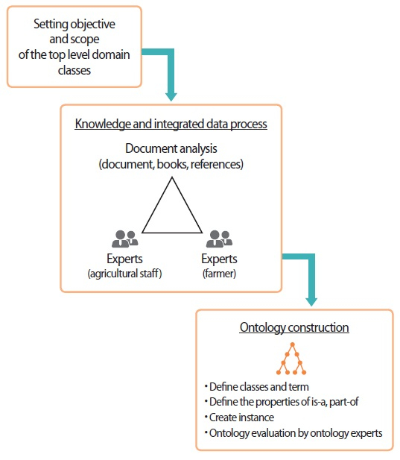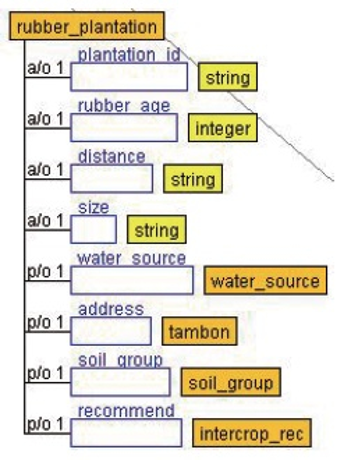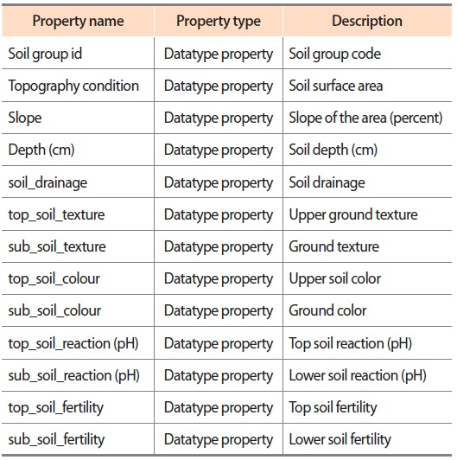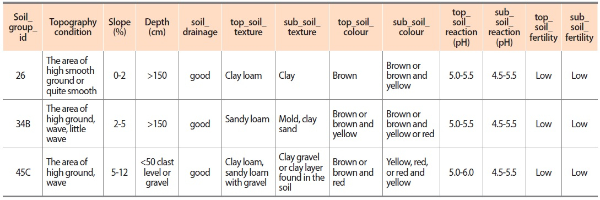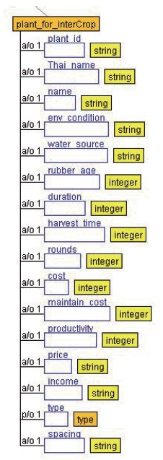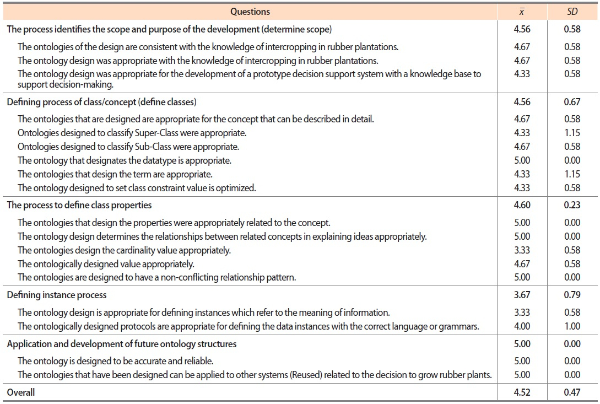ISSN : 2287-9099
Intercropping in Rubber Plantation Ontology for a Decision Support System

Massudi Mahmuddin (School of Computing, Universiti Utara Malaysia)

Azman Ta'a (School of Computing, Universiti Utara Malaysia)

Abstract
Planting intercropping in rubber plantations is another alternative for generating more income for farmers. However, farmers still lack the knowledge of choosing plants. In addition, information for decision making comes from many sources and is knowledge accumulated by the expert. Therefore, this research aims to create a decision support system for growing rubber trees for individual farmers. It aims to get the highest income and the lowest cost by using semantic web technology so that farmers can access knowledge at all times and reduce the risk of growing crops, and also support the decision supporting system (DSS) to be more intelligent. The integrated intercropping ontology and rule are a part of the decision-making process for selecting plants that is suitable for individual rubber plots. A list of suitable plants is important for decision variables in the allocation of planting areas for each type of plant for multiple purposes. This article presents designing and developing the intercropping ontology for DSS which defines a class based on the principle of intercropping in rubber plantations. It is grouped according to the characteristics and condition of the area of the farmer as a concept of the rubber plantation. It consists of the age of rubber tree, spacing between rows of rubber trees, and water sources for use in agriculture and soil group, including slope, drainage, depth of soil, etc. The use of ontology for recommended plants suitable for individual farmers makes a contribution to the knowledge management field. Besides being useful in DSS by offering options with accuracy, it also reduces the complexity of the problem by reducing decision variables and condition variables in the multi-objective optimization model of DSS.
- keywords
- ontology development, ontology to decision supporting system, intercropping ontology, knowledge-based decision supporting system, semantic web for decision supporting system
1. INTRODUCTION
Thailand has the second largest rubber plantation area in the world and is one of the world’s top rubber exporters (Bank of Thailand, 2016). However, many years ago, farmers were faced with a problem of low agricultural product prices. It is a persistent problem of growing monoculture crops. Therefore, the solution to this problem is to plant many crops in the area of the farm to reduce such risks. It also increases revenue and uses limited resources (land) to maximize benefits as well. Mousavi and Eskandari (2011) have suggested that intercropping in rubber plantations is a sustainable solution.
Plantation intercropping for farmers in Thailand is supported by the Department of Agriculture in the central and regional research centers. The support provides document formats and advice, as well as providing a learning center for field trips in various provinces. The research center is located in the southern region. It is an important rubber plantation area of Thailand. The recommended plants are short-lived plants such as beans, rice, corn fields, and chilies. However, farmers lack planting and production cost information (Jingjit, 2015). The way to learn is from successful farmers, a learning center, or a local philosopher (Office of Agricultural Economics, 2016). The trial involved identifying what and how much to plant with the available resources of farmers, and the investment costs and revenue estimates. From the above mentioned problems, we have the idea of developing a solution to the problem of planting space allocation. It includes the selection of suitable plants with several criteria. There are several purposes. In selecting the right plants, use of the web service can help decide which plants are suitable for farmers’ areas. It also allocates each area to suit the area conditions and individual farmer conditions together with the multi-purpose resource allocation model. That is, farmers have the highest annual income and the lowest cost, according to the principle of rubber plantations.
The semantic web can involve a huge amount of standard format data such as part numbers, titles, and dates, organized and found by semantic web tools. On-the-fly results from one SPARQL query are seamlessly produced from disparate databases (Lassila & Hendler, 2007) of linked data (Antunes, Freire, & Costa, 2016). Semantic web ontologies are vocabularies representing the relationships between concepts or knowledge through data structures, thus helping mutual understanding between people or software (Gruber, 1993).
Decision supporting system (DSS) usefully use ontologies for aspects of the decision-making process (Alshaiji, El Kadhi, Wang, & Al-Anzi, 2011; Salah, 2014; Shojanoori & Juric, 2015), distinguishing the state from the past in closed systems, and determining proportionated domain models and knowledge from a range of sources. Some of the inference stages of the DSS can be accomplished through state-of-the-art logical reasoning performance, such as rule logic providers or logical reasoning applied with a knowledge base (Buranarach, 2017), information integration and sharing, web service annotation and discovery, and knowledge representation and reasoning (Blomqvist, 2014), allowing one to interpret information exactly, to provide the user with accurate, reliable, and relevant information (Antunes et al., 2016).
There are two issues to decide for rubber plantation intercropping planning resource allocation: what and how much to plant. Multiple cropping maximizes the income from the constraints of limited space resources and conditions (e.g., soil plant disease, time) by minimizing costs through multi-criteria decision making as a multi-objective optimization problem.
The literature review about research related to multi-purpose area allocation found that the mathematical model chosen affected the selection of crops to be planted. For example, there is the analytic hierarchy process to select plants to grow in rubber plantations (Srisawat & Payakpate, 2016) and the hybrid technique by using analytic hierarchy process and technique for order preference by similarity to ideal solution (Worawimolwanich & Kesorn, 2015). A goal programming approach to rubber-tea intercropping (Sen & Nandi, 2012), and optimal land allocation in agricultural production planning using fuzzy goal programing (Mishra & Singh, 2016) provide for multi-objective optimization for crop planning. However, those approaches do not use logical reasoning with a knowledge-based approach. The challenge is how to make DSS able to recommend plants that are suitable for the area and allocate each plant’s area when there are more than two recommended plants for the maximizing of revenue and minimizing cost objective.
Therefore, the challenge is to design an intercropping ontology and rules into DSS for intercropping in the rubber plantation. The system can suggest suitable plants that grow well together in the rubber plantation areas. It focuses on ability in logical reasoning to provide precise instructions similar to experts, and sends related parameters about plants that suggest related plants to calculate multi-objective optimization programming, in order to give the answers which can support the suitable crops and the maximum yields and minimum cost for individual agriculture in the next step of research. This article presents the ontology creation only. It consists of various sections in the following order: a research methodology section, intercropping ontology design and development, ontology evaluation, and conclusions and next work in the last section.
2. RESEARCH METHODOLOGY
The ontology development involves seven steps by Noy and McGuinness (2001) including: determine the domain and scope of the ontology, consider reusing existing ontologies, enumerate terms in the ontology, define scope, define the properties, define constraints, and create instances (Fig. 1).
However, ontology development should be based on application objectives, the data characteristic context, rule, and future reuse feasibility (Jantzen, Mayo, & Patton, 2015; Kaewboonma, Tuamsuk, & Buranarach, 2014; Mawardi, Abdel-Aziz, Omran, & Mahmoud, 2013; Padmavathi & Krishnamurthy, 2014). Therefore, this ontology is intended to be an engine recommender for intercroping using a knowledgebased DSS framework as illustrated in Fig. 2.
The development process is divided into three main steps: Step 1, setting objective and scope domain classes; Step 2, knowledge and integrated data process using triangulation technique from document analysis, agricultural experts, and farmers’ experts; and Step 3, ontology construction applying Noy and McGuinness (2001) by defining classes and term, properties, create instance, and ontology evaluation as follows.
2.1. Setting Scope and Objective to Create Ontology
This research purposes to design and develop an intercropping ontology as knowledge-based in the DSS for the allocation of rubber plantation areas for many purposes. The scope of the study is to provide a knowledge-based approach for the DSS that recommends a suitable plant to be cultivated during the short-term returns within one year of cultivation. The farmers can earn income during the year and it must be a plant that has been planted by intercropping before, especially in the list of recommendations of the Department of Agricultural Extension.
2.2. Knowledge and Integrated Data Process
Based on the ontology for the agriculture domain, it is found that even though there are various research efforts and systems to help farmers, such as the development of ontologies for rice (Chariyamakarn, Boonbrahm, Boonbrahm, & Ruangrajitpakor, 2015) and ontology for plant diseases (Lagos-Ortiz, Medina-Moreira, Paredes-Valverde, Espinoza-Moran, & Valencia-Garcia, 2017), there was a lack of intercropping ontology. Therefore, knowledge management and data collection must be done from various sources. Knowledge from related sources regarding intercropping needs to be integrated in order to facilitate the management of the decision process so that the information obtained is accurate and reliable. Therefore, the triangulation method was adopted (Fielding, 2012) for the ontology development process. The data collection is based on three sources and methods: (1) secondary data, with analysis of documents obtained from research or public information; (2) four government offices staffed by three expert farmers, one land surveyor expert, and one expert from the Rubber Authority of Thailand; and (3) a focus group with expert farmers who have succeeded in growing rubber plantations, to verify the accuracy of the knowledge modeling and the criteria for selecting the suitable plants.
2.3. Ontology Design and Construction
The purpose of ontology construction is to apply knowledge that has been analyzed to design and develop intercropping in a rubber plantation ontology. This research used the Hozo-Ontology Editor ( http://www.hozo.jp) for building the ontology. Hozo is a free ontology editor which is capable of displaying the ontology structures in a graph model showing the relationship between concepts in an easy manner. This step will consist of Define classes and Terms, Define properties, and Create instance and ontology evaluation by experts.
Expert assessments select not less than three experts in ontology development in Thailand with experience of not less than five years, by selecting skilled and well-known people (Lynn, 1986). There should not be more than ten people because of the need for validity (Polit & Beck, 2006).
3. INTERCROPPING IN RUBBER PLANTATION ONTOLOGY
Intercropping in a rubber plantation is planting other plants in the empty space between rubber rows by choosing the right intercroping plants, by considering the environmental criteria of farmers’ rubber plantations. Important factors for choosing individual crops for agriculture are the age of the rubber tree and the rubber growing area of the soil. The age of the rubber tree and the spacing is related to the sunlight requirements of each plant. Then the water source and soil conditions are considered to determine the location of the rubber plantations. The soil group is based on the source of the farmers. That is the subdistrict (called “tambon” in Thai), which is surveyed by the Land Development Department (Office of Soil Resources Survey and Research, 2010). Definition of terms is shown in Table 1.
The personalized intercropping in rubber plantation ontology was developed using the Hozo ontology editor. The development process was based on the methodology shown in Fig. 2. It involved defining classes and terms, defining properties (is-a, part-of), and creating instances. The Web Ontology Language class properties can be divided into two types: the datatype property and the object property. In this research, the ontology is created by the Hozo program. Defining class type properties are: 1) Datatype property, which is a property with “a/o” relationship type and datatype such as string or integer, and 2) Object property, which is a property with “p/o” or part-of relationship, meaning a “component” with other classes. The object property that can be referenced to another class is also called the property chain. The concept of rubber plantations will mainly consider the plants grown from the rubber plantation environment of the farmers: that is, starting with the farmer class which has one object property, which is plantation. It shows the environment and information of farmers’ rubber plantations with relation to the rubber plantation class.
The concept of growing by intercropping will consider the different factors of each rubber plantation. Therefore, the “rubber plantation” class shows the abstract concept of the environment of each farmer’s rubber plantation and consists of rubber plantation information of farmers, whose properties consist of rubber age, distance between rows, size, water source, and an address that indicates the sub-district and the soil group in that sub-district. These properties indicate the type of plant that is suitable to be grown in the rubber plantations of each plot (Fig. 3) and the details of the property as are shown in Table 2.
Other classes that are related to the rubber plantation class, object property, have definitions, properties, subclasses, and sample data the same as rubber plantation by asking for soil group class. This is a class about the characteristics of the soil group. The Office of Soil Resources Survey and Research (2010) has defined and explained the characteristics of each soil series in Thailand. It contains of sub-class property definitions and data examples as shown in Tables 3 and 4.
The “plant for intercropping” class represents an abstract concept of plant item which is suitable for intercropping in an individual rubber plantation. It was classified as plants for intercropping according to the books about alternative ways for small para-rubber farmers as supplemented revenue (Department of Agriculture Extension, 2014). Their features and explanations are explained in Fig. 4 and Table 5.
In summary, the personalized intercropping in rubber plantation ontology includes of 8 classes, 46 properties, and 62 sub-class as shown in Fig. 5.
3.1. Ontology Evaluation
In this research, the evaluation will be divided into three parts, which are: Part 1) Examination of knowledge and decision-making by rubber planters before being built as an ontology and as a rule of the introduction of intercropping plantations for individual farmers. The criteria for decision making are the age of the rubber trees, distance between rows, water sources for agriculture, soil groups, and slope (Phoksawat & Mahmuddin, 2019); Part 2) Assessing the accuracy of the design and construction of the ontology by ontology experts; and Part 3) Evaluation of the accuracy of results suggested by the software with the results from experts in intercropping plantations. However, this article will present only the part of the evaluation of the accuracy of design and construction by ontology experts.
Ontology evaluation uses ontology experts for evaluation in design and structure to evaluate the accuracy of appropriate plant recommendations. Ontology evaluation is done by ontology development experts with more than five years’ experience. The tool is a questionnaire. The evaluation framework considers the class definition, relationships of each class, and characteristics of each class, as well as whether it is comprehensive and able to be used as intended (Brank, Grobelnik, & Mladenić, 2005; Poveda-Villalón, Suárez-Figueroa, & Gómez-Pérez, 2015; Gómez‐Pérez, 2001; Pick & Weatherholt, 2013). Therefore, the evaluation criteria consist of five main points which are 1) The process identifies the scope and purpose of the development; 2) Defining process of class/concept; 3) The process to define class properties; 4) Defining instance process; and 5) Application and development of future ontology structures. Questions on each point have been evaluated by three experts. The questionnaire is divided into three sections: 1) General information of the assessors; 2) The design and structure of ontology are in line with the standards and system requirements; and 3) Any suggestions which have been reviewed by experts before being evaluated by the questionnaire using the appropriate level of five levels. The results are shown in Table 6.
Overall, the ontology is very well-designed (ˉx=4.52, SD=0.47) and matched with the DSS for recommending plants for intercropping in rubber plantation of individual farmers. The researcher has introduced expert advice to improve the ontology in order to have a more complete and appropriate intercropping ontology to use in DSS.
4. CONCLUSION AND NEXT STEPS
This article presents how to create ontologies by adding a triangulation method which is designed to integrate knowledge and data from three sources: They are document analysis, expert interviewers (a person who has the duty to promote agriculture), and farmers who have expertise in rubber plantations, in order to obtain the knowledge model and the criteria for decision making in rubber plantations. The advantage is that it helps the researcher understand the concepts and relationships as well as various decision criteria. It will help in determining the rule-base and also validate data before creating an ontology with the ontology editor.
The result of this study is the intercropping ontology for DSS for recommended plants suitable for the area of each farmer using criteria of rubber age, spacing, and soil group condition, and the water resources used in agriculture. After that, the ontology was evaluated by the experts on ontology development and knowledge engineering.
The advantages of using experts to evaluate are that experts have the knowledge and experience to be able to provide good advice on how to improve the ontology for researchers; for example, technical advice for creating an ontology for the rubber plant recommendation system. It should add another class to use to support the results of the introduction of data from inferential processing. The researcher added the “Intercrop rec” class into the intercropping ontology as suggested.
The next step will create an ontology-based application to evaluate the results of the software once again before using the result as a variable to decide on a multi-objective optimization model in the final step of research.
Ack
Thanks go to the Department of Agricultural Extention, Land Development Regional 11 Office, Rubber Authority of Thailand, Nakhon Si Thammart Provincial Agriculture and Cooperatives Office for information on decision-making in rubber plantations, and the ontology development experts who devoted time to the evaluation. In addition, the authors would like to thank Rajamangala University of Technology Srivijaya for the supporting scholarship.
References
, Alshaiji, S., El Kadhi, N., Wang, Z., & Al-Anzi, F. S. (2011). , Fuzzy-based ontology intelligent DSS to strengthen government bilateral economic relations, . Paper presented at the Second Kuwait Conference on e-Services and e-Systems, Kuwait City, Kuwait., , Fuzzy-based ontology intelligent DSS to strengthen government bilateral economic relations., Paper presented at the Second Kuwait Conference on e-Services and e-Systems, (2011), Kuwait City, Kuwait
Report on major agricultural price trends in southern Thailand. (Bank of Thailand) ((2016), Retrieved May 12, 2019) Bank of Thailand. (2016). Report on major agricultural price trends in southern Thailand. Retrieved May 12, 2019 from https://www.bot.or.th/Thai/MonetaryPolicy/Southern/CommoitiesPriceReport/QuarterlyReport_on_AgriculturalCommodities_Q12016V4.pdf. , from https://www.bot.or.th/Thai/MonetaryPolicy/Southern/CommoitiesPriceReport/QuarterlyReport_on_AgriculturalCommodities_Q12016V4.pdf
A survey of ontology evaluation techniques. In D. Mladenić, & M. Grobelnik (Eds.), Proceedings of the Conference on Data Mining and Data Warehouses (SiKDD 2005) (, , ) ((2005)) Ljubljana: International multiconference Information Society Brank, J., Grobelnik, M., & Mladenić, D. (2005). A survey of ontology evaluation techniques. In D. Mladenić, & M. Grobelnik (Eds.), Proceedings of the Conference on Data Mining and Data Warehouses (SiKDD 2005) (pp. 166-169). Ljubljana: International multiconference Information Society. , pp. 166-169
, Buranarach, M. (2017). , Introduction to ontology-based data analysis, . Paper presented at the Joint International Symposium on Artificial Intelligence and Natural Language Processing (iSAI-NLP 2017), Tutorial Session, Hua-Hin, Thailand., , Introduction to ontology-based data analysis., Paper presented at the Joint International Symposium on Artificial Intelligence and Natural Language Processing (iSAI-NLP 2017), (2017), Tutorial Session, Hua-Hin, Thailand
Framework of ontology based recommendation for farmer centered rice production. In T. Threeramunkong, T. Yuizono, & A. M. J. Skulimowski (Eds.), Proceedings of the Tenth International Conference on Knowledge, Information and Creativity Support Systems (KICSS 2015) (, , , ) ((2015)) Thailand: Sirindhorn International Institute of Technology, Thammasat University Chariyamakarn, W., Boonbrahm, P., Boonbrahm, S., & Ruangrajitpakorn, T. (2015). Framework of ontology based recommendation for farmer centered rice production. In T. Threeramunkong, T. Yuizono, & A. M. J. Skulimowski (Eds.), Proceedings of the Tenth International Conference on Knowledge, Information and Creativity Support Systems (KICSS 2015) (pp. 376-387). Thailand: Sirindhorn International Institute of Technology, Thammasat University. , pp. 376-387
Alternatives way for small para-rubber farmers as supplemented revenue. (Department of Agriculture Extension) ((2014)) Bangkok: Department of Agriculture Extension, Ministry of Agiculture and Cooperatives Thailand Department of Agriculture Extension. (2014). Alternatives way for small para-rubber farmers as supplemented revenue. Bangkok: Department of Agriculture Extension, Ministry of Agiculture and Cooperatives Thailand.
Insights “Smart Farmer” just a new concept. Or reinvent agriculture Thailand. () ((2015), Retrieved May 12, 2019) Jingjit, R. (2015). Insights “Smart Farmer” just a new concept. Or reinvent agriculture Thailand. Retrieved May 12, 2019 from http://www.tpso.moc.go.th/sites/default/files/1074-img.pdf. , from http://www.tpso.moc.go.th/sites/default/files/1074-img.pdf
Optimal land allocation in agricultural production planning using fuzzy goal programming. In M. Pant, K. Deep, J. C. Bansal, A. Nagar, & K. N. Das (Eds.), Proceedings of Fifth International Conference on Soft Computing for Problem Solving: SocProS 2015, Volume 1 (, ) ((2016)) Singapore: Springer Mishra, B., & Singh, S. R. (2016). Optimal land allocation in agricultural production planning using fuzzy goal programming. In M. Pant, K. Deep, J. C. Bansal, A. Nagar, & K. N. Das (Eds.), Proceedings of Fifth International Conference on Soft Computing for Problem Solving: SocProS 2015, Volume 1 (pp. 287-298). Singapore: Springer. , pp. 287-298
Ontology development 101: A guide to creating your first ontology. (, ) ((2001), Retrieved May 12, 2019) Noy, N. F., & McGuinness, D. L. (2001). Ontology development 101: A guide to creating your first ontology. Retrieved May 12, 2019 from http://www.ksl.stanford.edu/people/dlm/papers/ontology-tutorial-noy-mcguinness.pdf. , from http://www.ksl.stanford.edu/people/dlm/papers/ontology-tutorial-noy-mcguinness.pdf
Agricultural statistics of Thailand 2016. (Office of Agricultural Economics) ((2016)) Bangkok: Office of Agricultural Economic, Ministry of Agriculture and Cooperatives Thailand Office of Agricultural Economics. (2016). Agricultural statistics of Thailand 2016. Bangkok: Office of Agricultural Economic, Ministry of Agriculture and Cooperatives Thailand.
Soil survey report of Nakhon Si Thammarat province. (Office of Soil Resources Survey and Research) ((2010)) Bangkok: Land Development Department, Ministry of Agriculture and Cooperatives Thailand Office of Soil Resources Survey and Research. (2010). Soil survey report of Nakhon Si Thammarat province. Bangkok: Land Development Department, Ministry of Agriculture and Cooperatives Thailand.
Did you validate your ontology? OOPS! In E. Simperl, B. Norton, D. Mladenic, E. Della Valle, I. Fundulaki, A. Passant, & R. Troncy (Eds.), The Semantic Web: ESWC 2012 Satellite Events (, , ) ((2015)) Berlin: Springer-Verlag Poveda-Villalón, M., Suárez-Figueroa, M. C., & Gómez-Pérez, A. (2015). Did you validate your ontology? OOPS! In E. Simperl, B. Norton, D. Mladenic, E. Della Valle, I. Fundulaki, A. Passant, & R. Troncy (Eds.), The Semantic Web: ESWC 2012 Satellite Events (pp. 402-407). Berlin: Springer-Verlag.
, Salah, H. A. (2014). Ontology development (OWL&UML) methodology of web-based Decision Support System for water management. In , Proceedings of the 2014 6th International Conference on Electronics, Computers and Artificial Intelligence (ECAI), (pp. 11-22). Red Hook: The Institute of Electrical and Electronics Engineers., , Ontology development (OWL&UML) methodology of web-based Decision Support System for water management., In Proceedings of the 2014 6th International Conference on Electronics, Computers and Artificial Intelligence (ECAI), (2014), Red Hook, The Institute of Electrical and Electronics Engineers, 11, 22
, Shojanoori, R., & Juric, R. (2015). Ontology design for supporting decision making in self care homes. In , Proceedings of the 2015 48th Hawaii International Conference on System Sciences, (pp. 3084-3093). Red Hook: The Institute of Electrical and Electronics Engineers., , Ontology design for supporting decision making in self care homes., In Proceedings of the 2015 48th Hawaii International Conference on System Sciences, (2015), Red Hook, The Institute of Electrical and Electronics Engineers, 3093, 3084
, Worawimolwanich, P., & Kesorn, K. (2015). , Decision support system for economic crops using hybrid approaches, . Paper presented at the 11th National Conference on Computing and Information Technology, Bangkok, Thailand., , Decision support system for economic crops using hybrid approaches., Paper presented at the 11th National Conference on Computing and Information Technology, (2015), Bangkok, Thailand
- Submission Date
- 2019-04-11
- Revised Date
- Accepted Date
- 2019-11-16
- 572Downloaded
- 1,014Viewed
- 0KCI Citations
- 0WOS Citations



